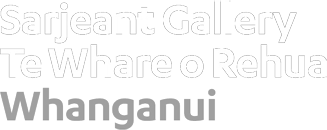Untitled
Peter Robinson, Artist
About the Work
A
triptych
from
the
artist's
Percentage
Series.
Peter
Robinson's
art
involves
an
exploration
of
ways
in
which
cultural
identity
is
defined,
exploited
and
even
traded
as
part
of
mass
culture.
He
admits
his
marginal
Māori
status,
using
it
here
to
show
in
graphic
fashion
the
watering
down
of
his
own
Māori
blood
through
successive
generations:
100%,
50%,
25%,
12.5%,
6.25%,
3.125%.
Robert Leonard has written that Robinson's Percentage paintings, of which this is one of the largest, "stake his claim to a Māori legacy and yet simultaneously seem to trivialize it, as if to question how much of a Māori he is or whether he's just jumping on a bandwagon.... The Percentage Paintings contribute to the ‘appropriation debate’ in which pakeha artists such as Walters and McCahon have been alternatively vilified and celebrated for their use of Māori imagery. Some understand their borrowings as homage, some condemn them as theft. Arguing that pakeha should not use these images both because they are ignorant of their meaning and because they are not related to them through whakapapa (genealogy), the prosecution conflates race and culture. The Percentage Paintings question the simplicity of the argument while siding with neither prosecution nor defense. They acknowledge that today’s Maori are inevitably partial, of mixed blood, whakapapa tying Māori and pakeha together as much as distinguishing them. They also present Māori and pakeha cultures as not pure, not distinct. Robinson gets his ‘Māori’ forms via Walters and McCahon as much as from indigenous tradition. Even the Rātana references are compelling in their impurity, their inventive deviation from tradition.
But the Percentage Paintings do much more. They challenge the prevailing notion of ‘authenticity’ in contemporary Māori art. Māori culture is typically presented as distinct, noble, sincere (no irony), spiritual, ecologically sound—a living tradition conflating the authentic with the well-appointed. While appearing PC, this misty-eyed essentialism masks economic and cultural disenfranchisement. It runs the risk of mocking and enhancing the sense of emptiness and displacement that many Maori feel, as if they are not real Māori because they do not walk the walk and talk the talk. The extent to which this identity mythology is less traditional than a construction of the present that simply refers to tradition, is seldom confronted."
Robert Leonard, '3.125% Pure: Peter Robinson Plays the Numbers Game' Art and Text, no.50, 1995. Available online http://robertleonard.org/3-125-pure-peter-robinson-plays-the-numbers-game/
Robert Leonard has written that Robinson's Percentage paintings, of which this is one of the largest, "stake his claim to a Māori legacy and yet simultaneously seem to trivialize it, as if to question how much of a Māori he is or whether he's just jumping on a bandwagon.... The Percentage Paintings contribute to the ‘appropriation debate’ in which pakeha artists such as Walters and McCahon have been alternatively vilified and celebrated for their use of Māori imagery. Some understand their borrowings as homage, some condemn them as theft. Arguing that pakeha should not use these images both because they are ignorant of their meaning and because they are not related to them through whakapapa (genealogy), the prosecution conflates race and culture. The Percentage Paintings question the simplicity of the argument while siding with neither prosecution nor defense. They acknowledge that today’s Maori are inevitably partial, of mixed blood, whakapapa tying Māori and pakeha together as much as distinguishing them. They also present Māori and pakeha cultures as not pure, not distinct. Robinson gets his ‘Māori’ forms via Walters and McCahon as much as from indigenous tradition. Even the Rātana references are compelling in their impurity, their inventive deviation from tradition.
But the Percentage Paintings do much more. They challenge the prevailing notion of ‘authenticity’ in contemporary Māori art. Māori culture is typically presented as distinct, noble, sincere (no irony), spiritual, ecologically sound—a living tradition conflating the authentic with the well-appointed. While appearing PC, this misty-eyed essentialism masks economic and cultural disenfranchisement. It runs the risk of mocking and enhancing the sense of emptiness and displacement that many Maori feel, as if they are not real Māori because they do not walk the walk and talk the talk. The extent to which this identity mythology is less traditional than a construction of the present that simply refers to tradition, is seldom confronted."
Robert Leonard, '3.125% Pure: Peter Robinson Plays the Numbers Game' Art and Text, no.50, 1995. Available online http://robertleonard.org/3-125-pure-peter-robinson-plays-the-numbers-game/
Measurements
1825 x 1520mm (single panel)
1825 x 4580mm (triptych)
1825 x 4580mm (triptych)
Media
oil stick and bitumen on canvas
Description
Three wall hung panels containing three rows of numbers and percentages painted in black on the first row, red in the middle row, and white in the bottom row, with black background.
Credit Line
Collection of the Sarjeant Gallery, Te Whare o Rehua Whanganui. Purchased, 1994
Collection Type
Permanent collection
Acquisition Date
27 Sep 1994
Share
Artist:
Nationality:
Ethnicity:
Iwi / Community:
Accession Number:
1994/15/1.1-3
